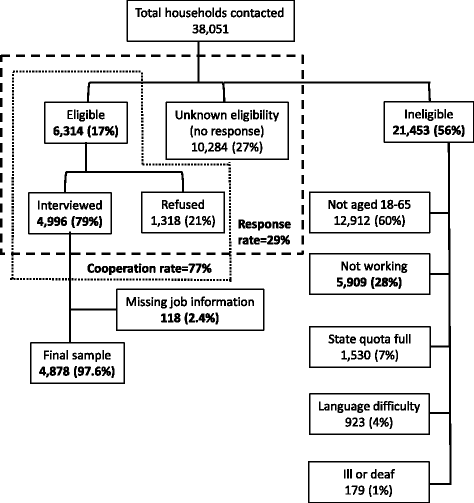The estimated prevalence of exposure to asthmagens in the Australian workforce, 2014
- PMID: 27061283
- PMCID: PMC4826519
- DOI: 10.1186/s12890-016-0212-6
The estimated prevalence of exposure to asthmagens in the Australian workforce, 2014
Abstract
Background: There is very little information available on a national level as to the number of people exposed to specific asthmagens in workplaces.
Methods: We conducted a national telephone survey in Australia to investigate the prevalence of current occupational exposure to 277 asthmagens, assembled into 27 groups. Demographic and current job information were obtained. A web-based tool, OccIDEAS, was used to collect job task information and assign exposure to each asthmagen group.
Results: In the Australian Workplace Exposure Study - Asthma (AWES- Asthma) we interviewed 4878 participants (2441 male and 2437 female). Exposure to at least one asthmagen was more common among men (47%) than women (40%). Extrapolated to the Australian population, approximately 2.8 million men and 1.7 million women were estimated to be exposed. Among men, the most common exposures were bioaerosols (29 %) and metals (27%), whilst the most common exposures among women were latex (25%) and industrial cleaning and sterilising agents (20%).
Conclusions: This study provides information about the prevalence of exposure to asthmagens in Australian workplaces which will be useful in setting priorities for control and prevention of occupational asthma.
Keywords: Occupational asthma; Surveillance; Workplace exposure.
Figures
References
-
- Hoy RF, Burgess JA, Benke G, Matheson M, Morrison S, Gurrin L, Walters EH, Dharmage SC, Abramson MJ. Occupational Exposures and the Development of New-onset Asthma: A Population-based Cohort Study From the Ages of 13 to 44 Years. J Occup Environ Med. 2013;55:235–9. - PubMed
-
- Donoghue AM, Frisch N, Ison M, Walpole G, Capil R, Curl C, Di Corleto R, Hanna B, Robson R, Viljoen D. Occupational asthma in the aluminum smelters of Australia and New Zealand: 1991–2006. Am J Ind Med. 2011;54:224–31. - PubMed
MeSH terms
Substances
LinkOut - more resources
Full Text Sources
Other Literature Sources
Medical


